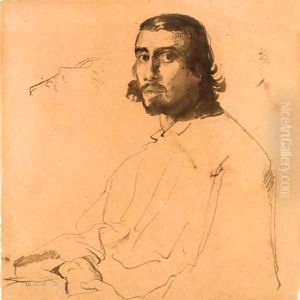Thodore Chassriau Paintings
Théodore Chassériau was a notable French painter of the early 19th century, born on September 20, 1819, in El Limón, Samaná, in what is now the Dominican Republic. He was the son of a Frenchman, Benoît Chassériau, and his mother, Maria Magdalena Couret de la Blagniére, was of Creole descent. The family moved to Paris in 1821, where Chassériau grew up and received his formative education and training.
At the tender age of 11, Chassériau entered the studio of Jean-Auguste-Dominique Ingres, who was one of the foremost Neoclassical painters of the time. Under Ingres' guidance, Chassériau honed his skills and was influenced by his teacher’s precise drawing style and Neoclassical aesthetic. However, as he matured, he began to be drawn to the more romantic and coloristic work of Eugène Delacroix. This tension between the Neoclassical discipline of Ingres and the Romantic sensibilities of Delacroix is evident throughout his career and is part of what gives Chassériau's work its distinctive character.
Chassériau's oeuvre covers a variety of genres including history painting, portraiture, religious works, and Orientalist scenes – the latter inspired by his travels to North Africa in 1846. He was appreciated for his skill in drawing and his use of color, which was often rich and sensuous. Among his notable works are 'The Two Sisters' (1843) and 'The Tepidarium' (1853), which show his ability to depict both the subtleties of the human form and the nuances of light and shadow.
Despite his talent, Chassériau's life and career were cut short when he died from a disease, believed to be cholera, on October 8, 1856, at the age of 37. Although he died young, his work had a significant impact on the artists of his time and the generation that followed. He is sometimes considered a ‘lost master’ of the 19th century, as his work bridges the gap between the Neoclassicism of Ingres and the emerging Symbolist movement, which would come to the fore in the latter part of the century. His art has been reevaluated and appreciated more in the modern era, with several retrospectives highlighting the unique qualities of his vision.
